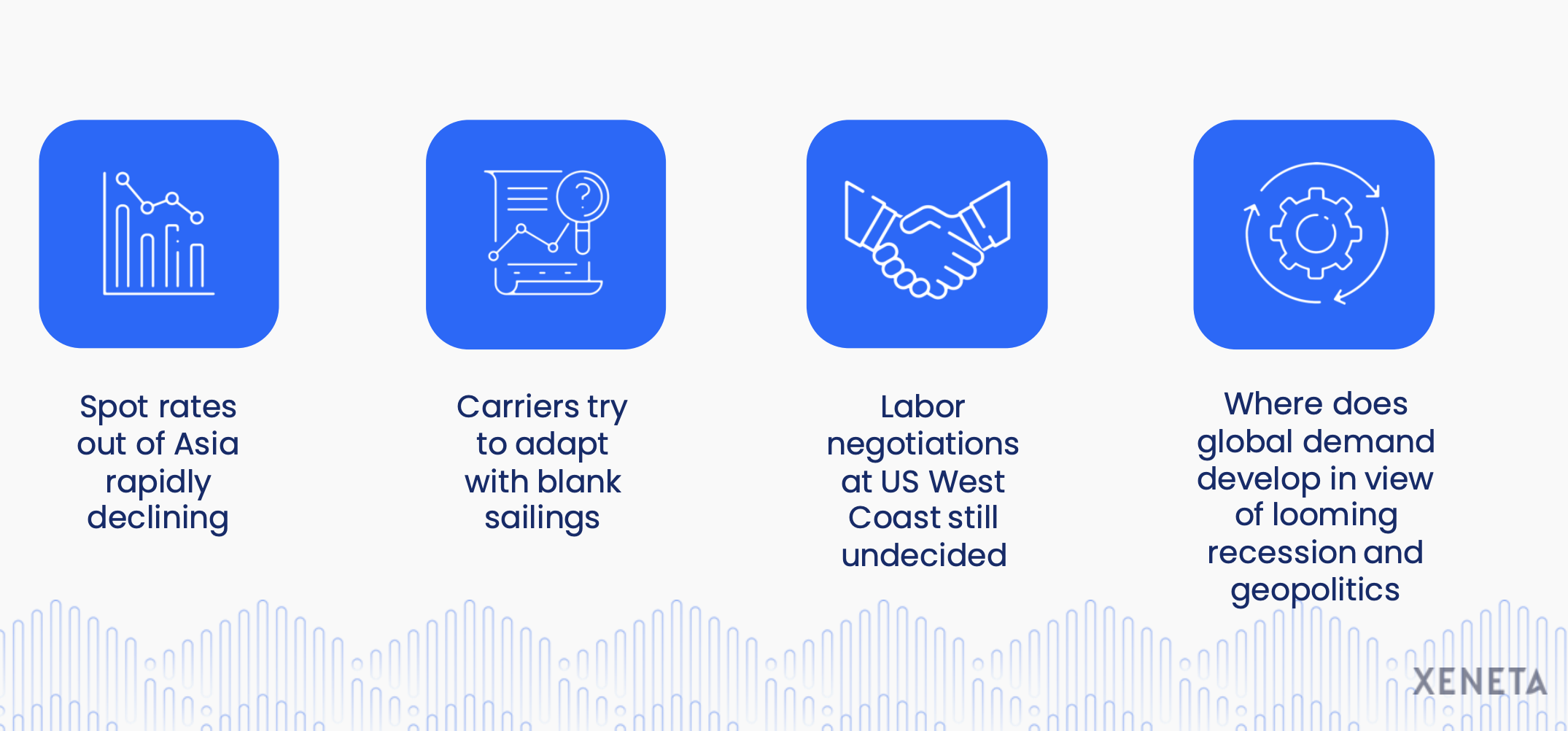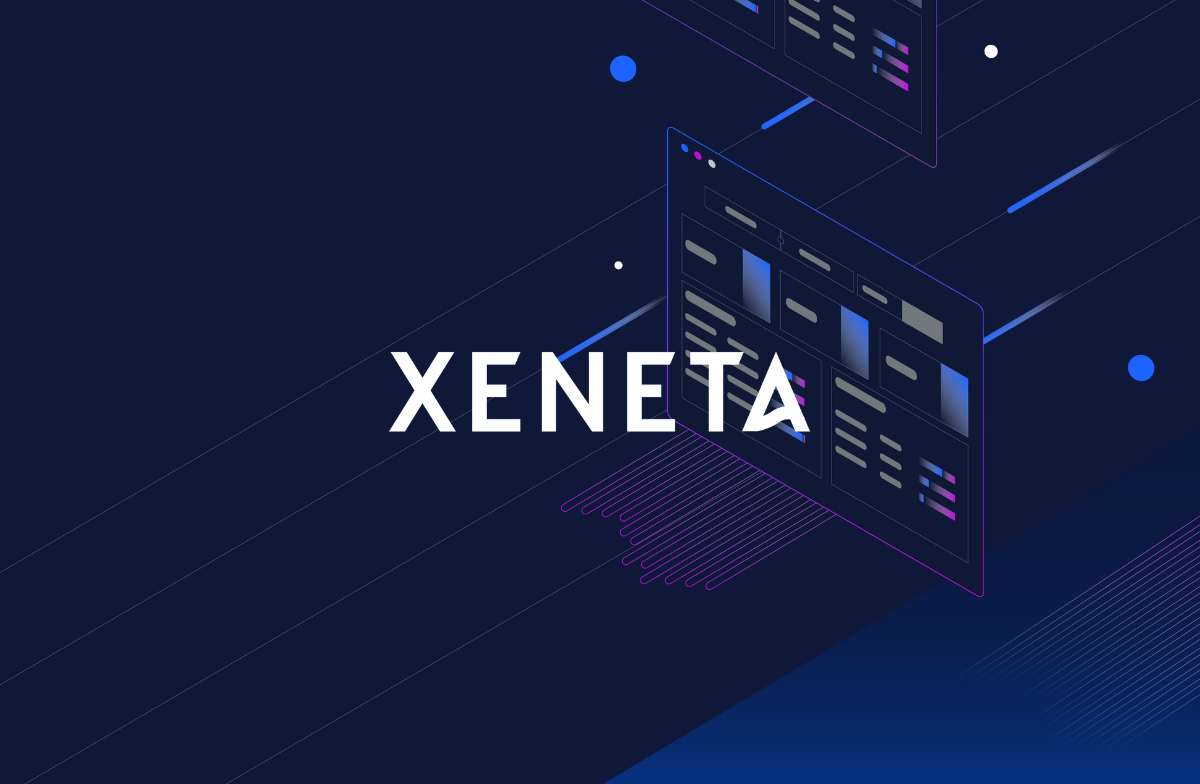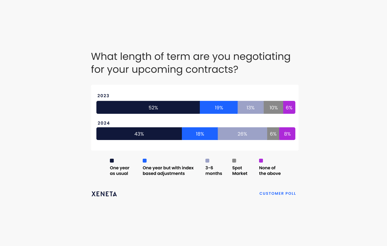Congestion is rapidly declining on the US East Coast, but canceled sailings into North America are on the rise. Volumes in North America are almost zero, with a typical YoY growth of 6%. Cargo volumes at the Port of Los Angeles fell for a second month in September, and the outlook remains “soft” for the rest of the year. (Source).
This trend in volumes is also increasing the pace at which spot rates are declining, especially in comparison to the past two years. What does this mean for global spot and long-term rates in Q4?
Tune in to the latest episode of our flagship State of the Ocean Market webinar and learn how you can take a competitive stance in this weaker market.
Note: Xeneta customers are invited to join the upcoming exclusive customer session. To learn more, please visit your 'Xeneta Customer Hub.'
Key Webinar Takeaways:
- How low will spot and long-term rates go as congestion eases?
- Mitigating the decrease in global consumer demand
- Negotiating/renegotiating in the weaker market
- Current freight rates across major trade lanes
State of The Market | Where Are We Now?
 Spot rates out of Asia are rapidly declining.
Spot rates out of Asia are rapidly declining.
Spot rates are collapsing on trade lanes out of Asia and certain other trades. However, the decline is focused on the major trades out of the Far East. Capacity is still there, but the demand isn't anymore. We see carriers quite quickly adapting their capacity, lowering their capacity to stop this real implosion in freight rates. So far, it has had very little effect.
Carriers try to adapt with blank sailings.
We see a high level of bank sailings, but the decline in freight rates is still ongoing. Compared to last year, we are coming from a high capacity level where a lot of the extra capacity was added to cater to the high demand and, in particular, high levels of congestion. But the situation has changed. Now we're seeing demand falling and over-capacity starting to become a big problem in the carrier market.
Labor negotiations on US West Coast are still undecided.
We are also still seeing continued problems or negotiations on the US West Coast, which remains a potential issue for many shippers.
"Some agreements have been met on some parts of the discussions. All of them depend on agreements being met more broadly, and I think it's clear that automation is still one of the key points and that they've not yet found any way to get around that," says Emily Stausbøll, market analyst at xeneta.
Global demand during looming recession and geopolitics
On one side, we have too much capacity, but on the other side, we're seeing falling demand, but not in nominal terms. Looking at the latest CTS data, we have a one-and-a-half percent drop in container demand.
The demand is falling much more on the longer trades, which are critical for global container shipping demand. However, we see growth on shorter trades like in Intra-Asia.
Available capacity is increasing as congestion eases
Congestion on the West Coast is on the edge of disappearing
"We're seeing in most places congestion is really improving while on some coasts it's still a big problem," says Emily while pointing out the considerable improvements on the US West coast.
The US East Coast is still dealing with record-high volumes. Here congestion is improving but not by much as we've seen in other places and as we've seen over the past many months. Due to the shift in volumes away from the West Coast towards the East Coast, ports are dealing with record-high volumes, which is causing delays.
On the other side, the US West coast is seeing considerable improvements. We also see improvements in Europe and China. So apart from certain exceptions, such as the US East Coast, globally, we're seeing congestion coming down and really freeing up all those extra ships.
Xeneta Platform Deep Dive
Want to learn More?
Watch the full webinar on-demand to start your journey toward data, not gut, -driven decisions, and empower your ocean freight procurement.
Note: Xeneta customers are invited to join the upcoming exclusive customer session. To learn more, please visit your 'Xeneta Customer Hub.'
%201.png)








